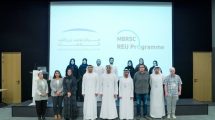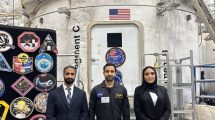 MBRSC has announced the results of conducting an analytical study to monitor the changes on Dubai coastlines during varying periods between 2009 and 2015. The study covered the natural geographical and human changes the Dubai coastline witnessed, from Al Mamzar Beach Park to the Dubai Waterfront Project and the Arabian Canal. This study classified the land attached to the coast, and identified the expansion and the partial and total erosion ratios. The study aims to calculate the length of the Dubai coast in 2015 and provide an estimated futuristic vision of the coastline.
MBRSC has announced the results of conducting an analytical study to monitor the changes on Dubai coastlines during varying periods between 2009 and 2015. The study covered the natural geographical and human changes the Dubai coastline witnessed, from Al Mamzar Beach Park to the Dubai Waterfront Project and the Arabian Canal. This study classified the land attached to the coast, and identified the expansion and the partial and total erosion ratios. The study aims to calculate the length of the Dubai coast in 2015 and provide an estimated futuristic vision of the coastline.
The study divided the Dubai coastline into eight zones (A, B, C, D, E, F, G, H) and showed a partial expansion in different parts of the coast at about 6%, due to a number of vital projects taking place in the emirate, such as the completion of Al Mamzar Corniche Beach, the 1000 metre-long project, Jumeirah Bay Island, Jumeirah One Beach (1380 metres) renovation project and Pearl Jumeirah, as well as the Umm Suqeim 1 and 2 Beach upgrade project, Bluewaters Island and the Dubai Water Canal project. The study showed the construction of a number of breakwaters in order to protect the coast from medium-high waves, in addition to the construction of sand barriers in order to stop coastal erosion and sediment transport and to preserve the coast.
The study relied on the use of satellite images of Dubai coastline: (a) image captured by DubaiSat-1 in 2009 at a resolution of 2.5 metres, (b) an aerial image of the area captured in 2011 at a resolution of 0.5 metres (from Dubai Municipality) and (c) image captured by DubaiSat-2 in 2015 at a resolution of 1 metre. To conduct the study, the resolution degree of the used images was unified, so that all the images had a resolution of 2.5 metres in order to maintain the same scale ratio, which is one of the most important success factors of the study that is based on comparison and analysis.
H.E. Yousuf Hamad Al Shaibani, Director General, MBRSC said: “The Dubai coastline changes monitoring study serves as a testament and a good example of the important aspects and uses of space images and applications.”
He also pointed out that MBRSC cooperates with various local government entities and provides services, research and studies that will benefit the development plans of the emirate and the country, benefit individuals and achieve happiness.
“The results of the study shows the vital growth Dubai is witnessing, as the land expansion is the result of man-made projects, many of which are developmental and touristic. This reflects the emirate’s long-term plans for the tourism, commercial sectors and infrastructure, in line with the sound vision of His Highness Sheikh Mohammed bin Rashid Al Maktoum, UAE Vice President and Prime Minister and Ruler of Dubai,” Al Shaibani added.
Zone A witnessed a slight fall back in the land, estimated at 0.13% as a result of the partial changes Deira Island coastline underwent, in addition to the removal of the sandy areas in the coasts overlooking Dubai Creek and Dubai Maritime City Authority.
The study zones B and C witnessed a significant urban development, which in turn, added an expansion along the coast estimated at 2.22%; this is represented in developing Pearl Jumeirah, completing the construction works of Jumeirah Bay Island and establishing Dubai Water Canal.
Zone D witnessed a slight expansion of land in Al Sufouh 1 and 2, estimated at 0.13%, while zones E, F and G witnessed a significant increase in land proportion of the coast estimated at 1.65%; this is represented in a coastal expansion at different places including Palm Islands and Skydive Dubai located opposite Dubai Marina, as well as the expansion of land in the man-made island that was created to serve as a new containers station for Jebel Ali Port. The study also shows that zone H (representing Dubai Waterfront and the Arabian Canal) witnessed minor human activities that did not significantly affect the coastal landscape.
Saeed Al Mansoori, Head of the Applications Development and Analysis Centre at MBRSC said: “This study is the first of its kind in monitoring the changes Dubai coastline has undergone. It took us three months (from January until March 2016) to conduct the study, during which we relied on the near infrared in DubaiSat-1 and DubaiSat-2 images to distinguish between land and water. We also applied geometric theories and laws to identify the coastline. The images used in the study were captured during the summer when there are no clouds, in order to get detailed and accurate results and analytical readings.”
“The study is one of a number of analytical studies that we prepare periodically at MBRSC in order to provide analytical information for a large sector of government and educational institutions in the country,” Al Mansoori added.
Al Mansoori and Analyst Fatima Al Marzooqi conducted this study, with Al Mansoori set to submit a presentation at the 2016 SPIE of Optics and Photonics Conference, to be held in the United Kingdom from 26th-29th September, shedding light on the study and highlighting the working mechanism of the innovative application to identify coastlines using satellite imagery.












Add Comment